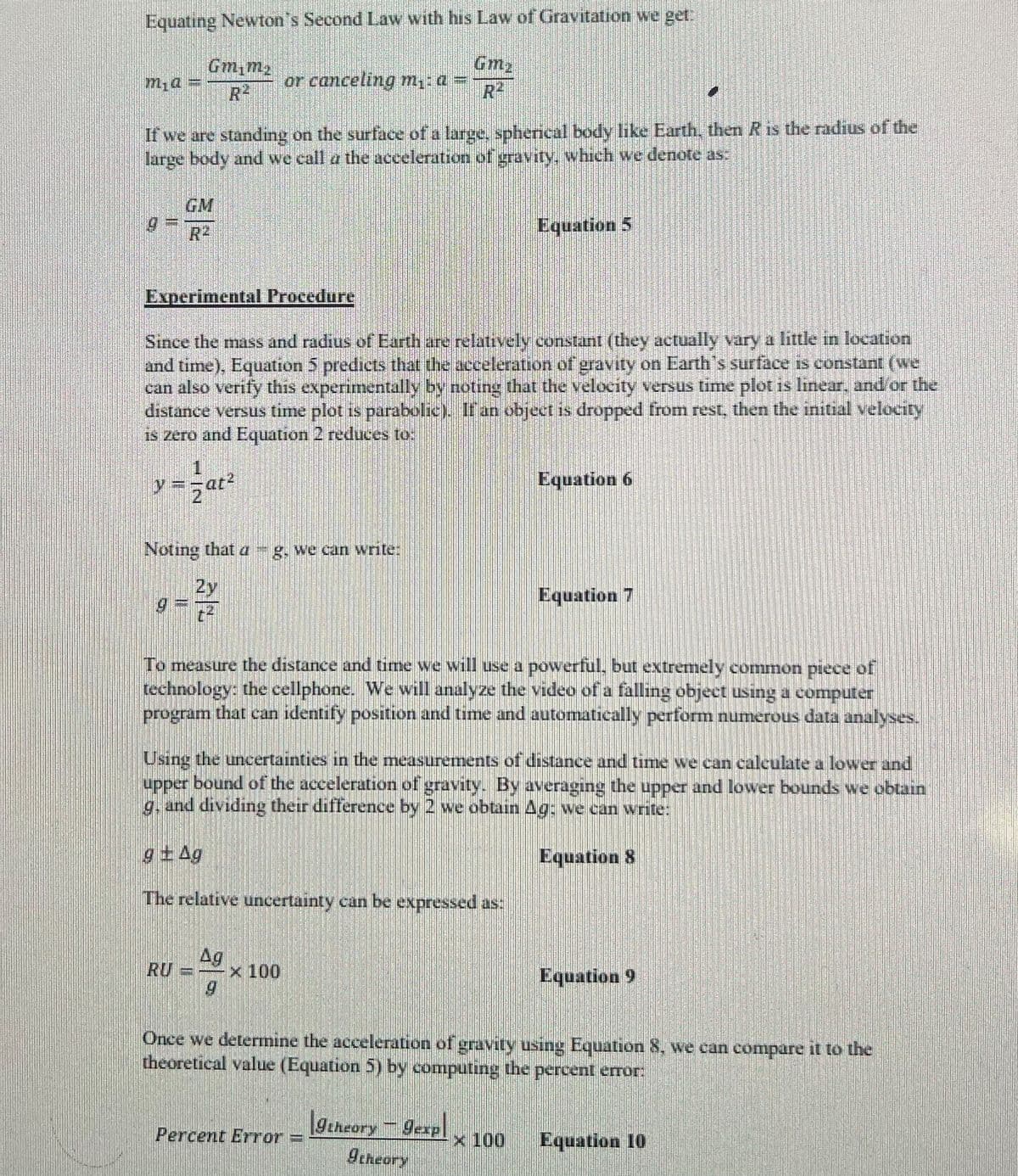4. Using the uncertainties in this experiment a student found that the lower and upper bounds of g are 9.4 m/s2 and 9.9 m/s2, respectively. Report g as in Equation 8.
4. Using the uncertainties in this experiment a student found that the lower and upper bounds of g are 9.4 m/s2 and 9.9 m/s2, respectively. Report g as in Equation 8.
College Physics
1st Edition
ISBN:9781938168000
Author:Paul Peter Urone, Roger Hinrichs
Publisher:Paul Peter Urone, Roger Hinrichs
Chapter34: Frontiers Of Physics
Section: Chapter Questions
Problem 20PE: (a) Use the Heisenberg uncertainty principle to calculate the uncertainty in energy for a...
Related questions
Question
need help with this question

Transcribed Image Text:4. Using the uncertainties in this experiment a student found that the lower and upper bounds of
g are 9.4 m/s² and 9.9 m/s, respectively. Report g as in Equation 8.
2

Transcribed Image Text:Equating Newton's Second Law with his Law of Gravitation we get
Gm,m2
Gm2
or canceling m,: a =
R-
If we are standing on the surface of a large, spherical body like Earth, then R is the radius of the
large body and we call a the acceleration of gravity, which we denote as:
GM
R2
Equation 5
Experimental Procedure
Since the mass and radius of Earth are relatively constant (they actually vary a little in location
and time), Equation 5 predicts that the acceleration of gravity on Earth's surface is constant (we
can also verify this experimentally by noting that the velocity versus time plot is linear, and/or the
distance versus time plot is parabolic). Ifan object is dropped from rest, then the initial velocity
is zero and Equation 2 reduces to:
1.
at2
Equation 6
Noting that a g. we can write:
2y
Equation 7
To measure the distance and time we will use a powerful, but extremely common piece of
technology: the cellphone. We will analyze the video of a falling object using a computer
program that can identify position and time and automatically perform numerous data analyses.
Using the uncertainties in the measurements of distance and time we can calculate a lower and
upper bound of the acceleration of gravity. By averaging the upper and lower bounds we obtain
g, and dividing their difference by 2 we obtain Ag: we can write:
gtAg
Equation 8
The relative uncertainty can be expressed as:
Ag
RU = x 100
Equation 9
Once we determine the acceleration of gravity using Equation 8, we can compare it to the
theoretical value (Equation 5) by computing the percent error.
9eneorygexpl
Percent Error =
x 100
Equation 10
9cheory
Expert Solution
This question has been solved!
Explore an expertly crafted, step-by-step solution for a thorough understanding of key concepts.
Step by step
Solved in 2 steps

Knowledge Booster
Learn more about
Need a deep-dive on the concept behind this application? Look no further. Learn more about this topic, physics and related others by exploring similar questions and additional content below.Recommended textbooks for you

College Physics
Physics
ISBN:
9781938168000
Author:
Paul Peter Urone, Roger Hinrichs
Publisher:
OpenStax College


College Physics
Physics
ISBN:
9781305952300
Author:
Raymond A. Serway, Chris Vuille
Publisher:
Cengage Learning

College Physics
Physics
ISBN:
9781938168000
Author:
Paul Peter Urone, Roger Hinrichs
Publisher:
OpenStax College


College Physics
Physics
ISBN:
9781305952300
Author:
Raymond A. Serway, Chris Vuille
Publisher:
Cengage Learning

College Physics
Physics
ISBN:
9781285737027
Author:
Raymond A. Serway, Chris Vuille
Publisher:
Cengage Learning

Physics for Scientists and Engineers with Modern …
Physics
ISBN:
9781337553292
Author:
Raymond A. Serway, John W. Jewett
Publisher:
Cengage Learning

Principles of Physics: A Calculus-Based Text
Physics
ISBN:
9781133104261
Author:
Raymond A. Serway, John W. Jewett
Publisher:
Cengage Learning